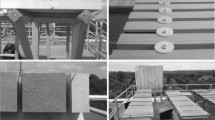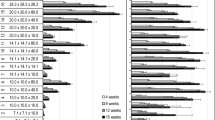Abstract
In this study, Scots pine sapwood (Pinus sylvestris L.) and Douglas fir heartwood (Pseudotsuga menziesii Franco) specimens were exposed in double layer field trials at four different exposure sites and under different exposure conditions (in total ten test sets). The material climate of wood in terms of wood moisture content (MC) and wood temperature was automatically monitored over a period of 6 years and compared with the progress of decay. The aim of this study was to highlight the interrelationship between microclimate, material climate, and decay as a basis for the establishment of dose-response functions to be used for service life prediction of wood and wood-based products. Differences in resulting decay dynamics between the test sites as well as between the different types of exposure were quantified and discussed with respect to corresponding microclimatic and material climatic conditions. The time between the beginning of exposure and the first occurrence of visible decay varied between the sites and influenced the total decay development. The fundamental importance of direct decay factors, such as MC and wood temperature, were underlined and basic requirements for establishing dose-response-functions to be used in service life prediction models were derived.






Similar content being viewed by others
References
Arndt U, Willeitner H (1969) Zum Resistenzverhalten von Holz bei natürlicher Bewitterung. Holz Roh- Werkst 27:179–188
Augusta U (2007) Untersuchung der natürlichen Dauerhaftigkeit wirtschaftlich bedeutender Holzarten bei verschiedener Beanspruchung im Außenbereich. Dissertation, University of Hamburg, Hamburg, Germany
Augusta U, Rapp AO, Eckstein D (2004) Dauerhaftigkeit der wichtigsten heimischen Hölzer bei realitätsnaher Prüfung unter bautypischen Bedingungen. Abschlussbericht zum Forschungsprojekt G99-14 der Deutschen Gesellschaft für Holzforschung, München
Banerjee AK, Levy JF (1971) Fungal succession in wooden fence poles. Mater Organ 6:1–25
Behrendt CJ, Blanchette RA, Farrell RF (1995) An integrated approach, using biological and chemical control, to prevent blue stain in pine logs. Can J Bot 73:613–619
Boutelje JB, Hägglund G (1988) Permeability measurements on surface layers for detecting wood with abnormally high permeability. Document IRG/WP 2298. International Research Group on Wood Protection, Stockholm
Brischke C, Rapp AO (2005) Experimental approach for service life prediction of wooden materials. Document TT6-198. In: Proceedings of the 10th international conference on durability of building materials and components, Lyon, France, 17–21 April 2005
Brischke C, Rapp AO, Bayerbach R (2006) Decay influencing factors: A basis for service life prediction of wood and wood-based products. Wood Mater Sci Eng 1:91–107
Brischke C, Rapp AO, Bayerbach R (2007a) Measurement system for long-term moisture recording with internal conductively glued electrodes. Building and Environment, published online, doi:10.1016/j.buildenv.2007.10.002
Brischke C, Welzbacher CR, Rapp AO, Augusta U (2007b) Dauerhaftigkeit heimischer Holzarten in verschiedenen Gebrauchsklassen & Feuchteschutz durch Hydrophobierung mit vegetabilen Ölen. In: Tagungsband zur 13. Quedlinburger Holzbautagung, Quedlinburg, Germany, 29–30 March 2007
Carey JK (2002a) L-joint trials: Part 1: observations on the process of colonisation and decay. Document IRG/WP 02-20250. International Research Group on Wood Protection, Stockholm
Carey JK (2002b) L-joint trials: Part 2: The relationship between colonisation by decay fungi and long-term performance. Document IRG/WP 02-20251. International Research Group on Wood Protection, Stockholm
CEN/TS 15083-2 (2005) Durability of wood and wood-based products – determination of natural durability of solid wood against wood-destroying fungi, test methods – Part 2: Soft rotting micro-fungi
Choi SM, Ruddick JNR, Morris PI (2003) Fungal colonization of CCA-treated decking. IRG/WP 03-10491. International Research Group on Wood Protection, Stockholm
Derbyshire H, Carey JK (2001) Evaluating joinery preservatives: Performance prediction using BS EN 330 L-joint-trials (IP2/01). BRE, Watford
Dunleavy JA, McQuire AJ (1970) The effect of water storage on the cell-structure of Sitka spruce (Picea sitchensis) with reference to its permeability and preservation. J Inst Wood Sci 26:20–28
Eberhardt TL, Han JS, Micales JA, Young RA (1994) Decay resistance in conifer seed cones: Role of resin acids as inhibitors of decomposition by white rot fungi. Holzforschung 48:278–284
Edlund M-L (1998) Durability of untreated wood exposed in terrestrial test fields and microcosms. Mater Organ 32:253–275
EN 252 (1989) Field test method for determining the relative protective effectiveness of wood preservatives in ground contact
EN 335 (2006) Durability of wood and wood-based products – definition of use classes
Findlay WPK (1966) Ecology of wood-destroying and wood-inhabiting fungi. In: Becker G, Liese W (eds) Holz und Organismen 1. Duncker & Humblot, Berlin, pp 199–211
Fojutowski A (2005) The influence of fungi causing blue-stain on absorptiveness of Scotch pine wood. Document IRG/WP 05-10565. International Research Group on Wood Protection, Stockholm
Greaves H (1970) The effect of selected bacteria and actinomycetes on the decay capacity of some wood-rotting fungi. Mater Organ 5:265–279
Greaves H (1972) Influence of a mixed microbial population on Basidiomycete decay. Mater Organ 7:11–25
Greaves H (1977) An illustrated comment on the soft rot problem in Australia and Papua New Guinea. Holzforschung 31:71–79
Green BJ, Tovey ER, Sercombe JK, Blachere FM, Beezhold DH, Schmechel D (2006) Airborne fungal fragments and allergenicity. Med Mycol 44:245–255
Gref R, Håkansson C, Henningsson B, Hemming J (2001) Influence of wood extractives on brown and white rot decay in Scots pine heart-, light- and sapwood. Mater Organ 33:119–128
Henningsson B (1967) Interactions between micro-organisms found in birch and aspen pulpwood. Studia Forstalia Suecica 53:1–31
Jacquiot C (1968) Antagonistic action of bacteria against fungi and its role in the preservation of pulpwood chips. BWPA Annu Conv 1468:1–3
Kasprzyk I, Worek M (2006) Airborne fungal spores in urban and rural environments in Poland. Aerobiologia 22:169–176
Lee DH, Takahashi M, Tsunoda K (1992) Fungal detoxification of organoiodine wood preservatives. 1. Decomposition of the chemicals in shake cultures of wood-decaying fungi. Holzforschung 46:81–86
Leicester RH, Wang C-H, Nguyen MN, Foliente GC (2005) Engineering models for biological attack on timber. Document TT4-217. In: Proceedings of the 10th conference on durability of building materials and components, Lyon, France, 17–21 April 2005
Morton HL, French DW (1966) Factors affecting germination of spores of wood-rotting fungi on wood. For Prod J 16:25–30
Panten H, Schnitzler J-P, Steinbrecher R (1996) Wirkung von Ultraviolettstrahlung auf Pflanzen. Nat.wiss Rundsch 49:343–346
Polman JE, Michon SGL, Militz H (1991) Accelerated wood decay in a soil-bed test under greenhouse conditions compared with a stake test under field conditions. Document IRG/WP/2384. International Research Group on Wood Protection, Stockholm
Preston A, Walchewski P, Archer K, Zahora A, Jin L (2000) The ground proximity decay test method. IRG/WP 00-20205. International Research Group on Wood Protection, Stockholm
Rapp AO, Augusta U (2004) The full guideline for the double layer test method – a field test method for determining the durability of wood out of ground. Document IRG/WP 04-20290. International Research Group on Wood Protection, Stockholm
Rapp AO, Berninghausen C, Bollmus S, Brischke C, Frick T, Haas T, Sailer M, Welzbacher CR (2005) Hydrophobierung von Holz – Erfahrungen aus 7 Jahren Freilandtests. 24. Holzschutz-Tagung, Leipzig, Germany, 12–13 April 2005
Rayner ADM, Boddy L (1988) Fungal decomposition of wood. Its biology and ecology. Wiley, Chichester
Rydell Å, Bergström M, Elowson T (2005) Mass loss and moisture dynamics of Scots pine (Pinus sylvestris L.) exposed outdoors above ground in Sweden. Holzforschung 59:183–189
Rypáĉek V (1966) Biologie holzzerstörender Pilze. VEB Gustav Fischer Verlag, Jena
Schmidt O (2006) Wood and tree fungi. Biology, damage, protection, and use. Springer, Berlin
Schmidt EL, French DW (1979) Sterilisation method effects on germination of wood decay fungus spores observed by the contact agar method. Phytopathology 69:688–689
Schmidt O, Müller J (1996) Praxisversuche zum biologischen Schutz von Kiefernholz vor Schimmel und Schnittholzbläue. Holzforsch Holzverwert 48:81–84
Stirling R, Morris PI (2006) The influence of extractives on western red cedar’s equilibrium moisture content. Document IRG/WP 06-40331. International Research Group on Wood Protection, Stockholm
Vasiliauskas R, Lygis V, Larsson K-H, Stenlid J (2005) Airborne fungal colonisation of coarse woody debris in North-temperate Picea abies forest: impact of season and local spatial scale. Mycol Res 109:487–496
Viitanen HA (1997) Modelling the time factor in the development of brown rot decay in pine and spruce sapwood – the effect of critical humidity and temperature conditions. Holzforschung 51:99–106
Viitanen HA, Ritschkoff A-C (1991) Brown rot decay in wooden constructions. Effect of temperature, humidity and moisture. Swedish University of Agricultural Sciences, Department of Forest Products, Report No. 222
Wakeling RN (2006) Is field test data from 20 × 20 mm stakes reliable? Effects of decay hazard, decay type and preservative depletion hazard. Document IRG/WP 06-20327. International Research Group on Wood Protection, Stockholm
Wallace DF, Dickinson DJ (2004) 16S rRNA Analysis of the bacteria associated with biocide degradation. Document IRG/WP 04-10543. International Research Group on Wood Protection, Stockholm
Wong AHH, Morsing N, Henriksen KH, Ujang S (2004) Above ground microbial decay test of biocide treated and untreated wood exposed to Danish and humid tropical climates. Document IRG/WP 04-20306. International Research Group on Wood Protection, Stockholm
Author information
Authors and Affiliations
Corresponding author
Rights and permissions
About this article
Cite this article
Brischke, C., Rapp, A.O. Influence of wood moisture content and wood temperature on fungal decay in the field: observations in different micro-climates. Wood Sci Technol 42, 663–677 (2008). https://doi.org/10.1007/s00226-008-0190-9
Received:
Published:
Issue Date:
DOI: https://doi.org/10.1007/s00226-008-0190-9




